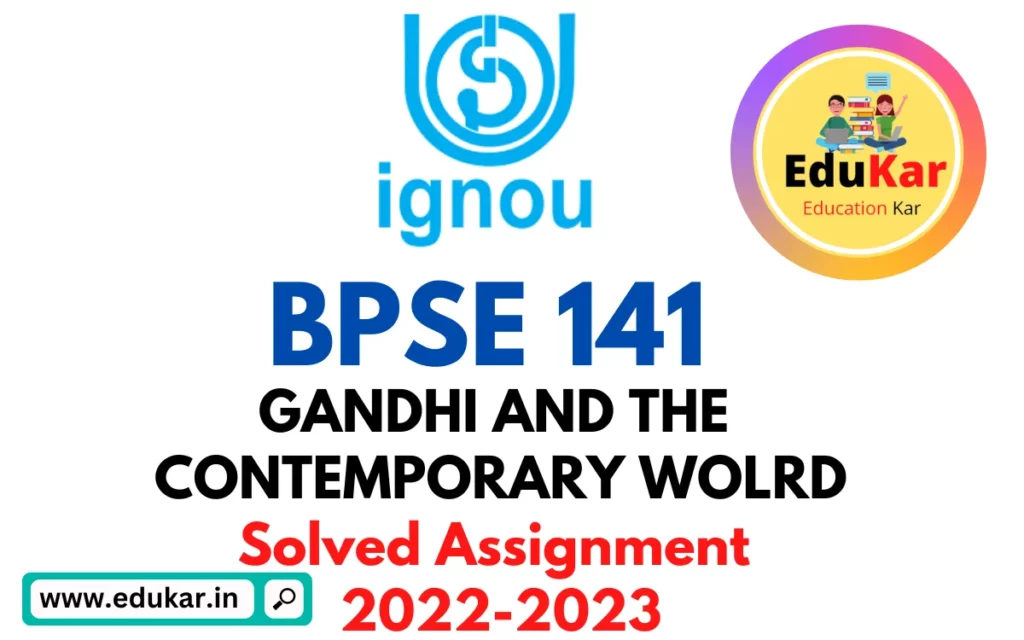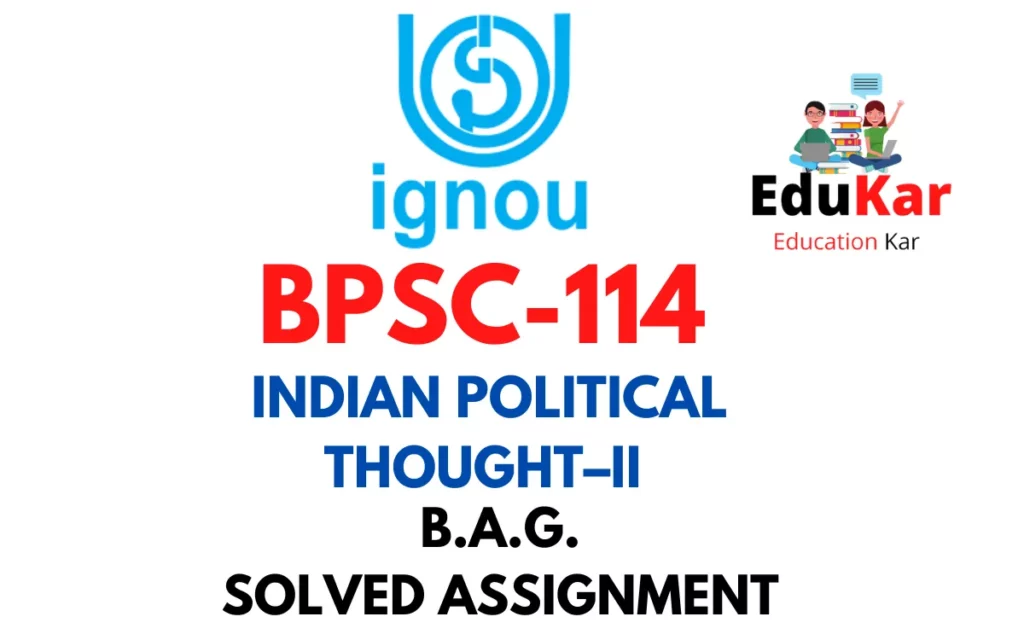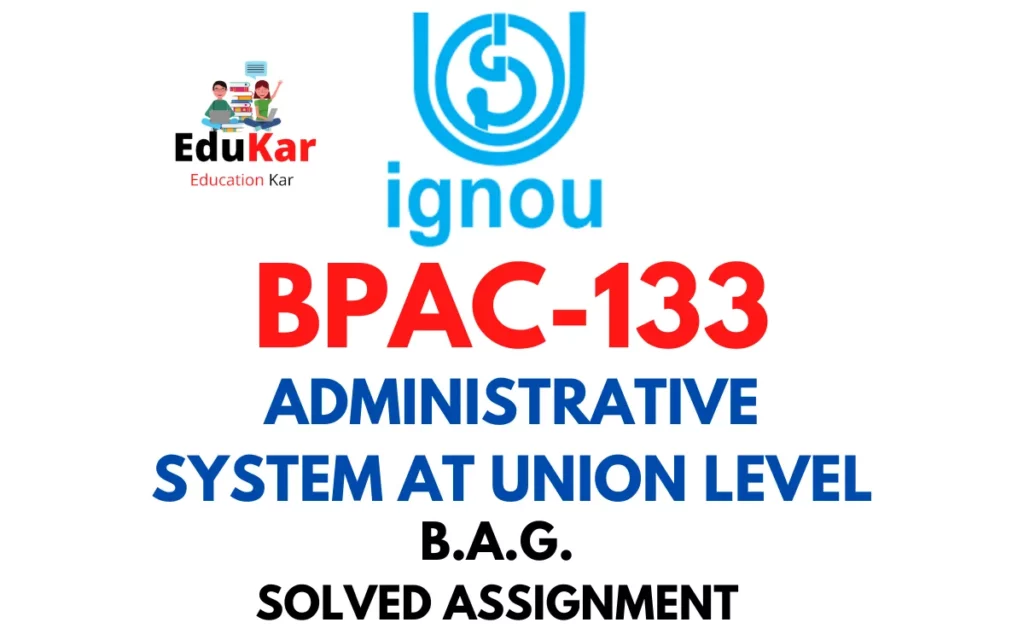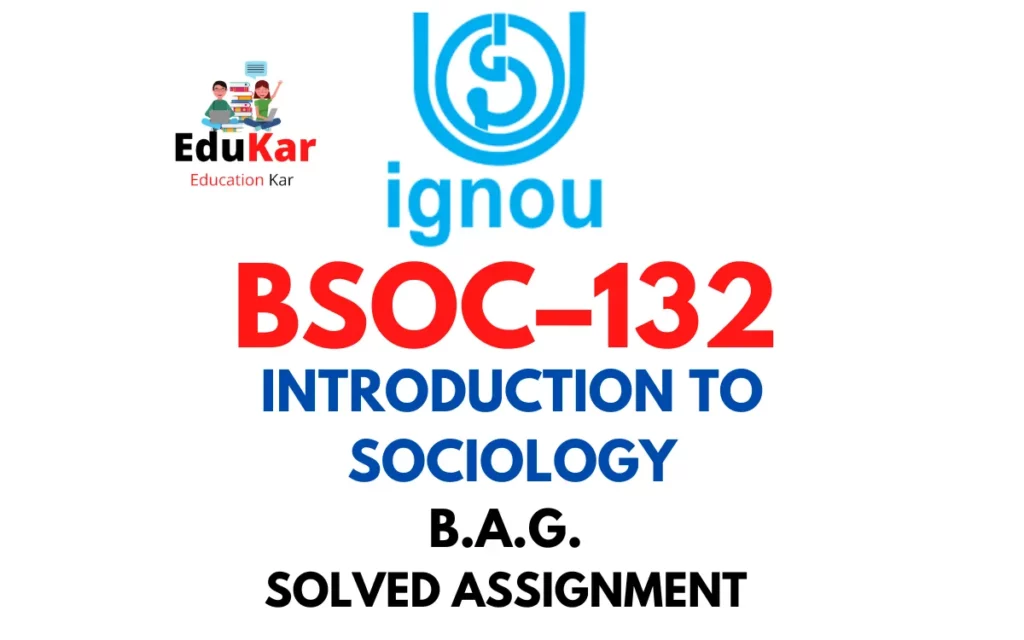Contents
- 1 Assignment – I
- 2 Answer the following questions in about 500 words each.
- 3 1. Discuss the various phases of the Civil Disobedience Movement.
- 4 2. Analyse the factors that led to the partition of India.
- 5 Assignment – II
- 6 Answer the following questions in about 250 words each.
- 7 3. Write a note on the Non-Cooperation movement.
- 8 4. Describe the world of Indian Literature in the first half of twentieth century.
- 9 5. Discuss the non-Brahman movements in western and southern India.
- 10 Assignment – III
- 11 Answer the following questions in about 100 words each.
- 12 6. Azad Hind Fauj
- 13 7. Nehru Report (1928)
- 14 8. Reform Movements in nineteenth-century India
- 15 9. Drain of Wealth
- 16 10. Revolutionary Nationalists in Bengal

| Title | BHIC-113: IGNOU BAG Solved Assignment 2022-2023 |
| University | IGNOU |
| Degree | Bachelor Degree Programme |
| Course Code | BHIC-113 |
| Course Name | History of India-VIII (C. 1857-1950) |
| Programme Name | Bachelor of Arts (General) |
| Programme Code | BAG |
| Total Marks | 100 |
| Year | 2022-2023 |
| Language | English |
| Assignment Code | BHIC-113/AST/TMA/2022-2023 |
| Last Date for Submission of Assignment: | For June Examination: 31st April For December Examination: 30th September |
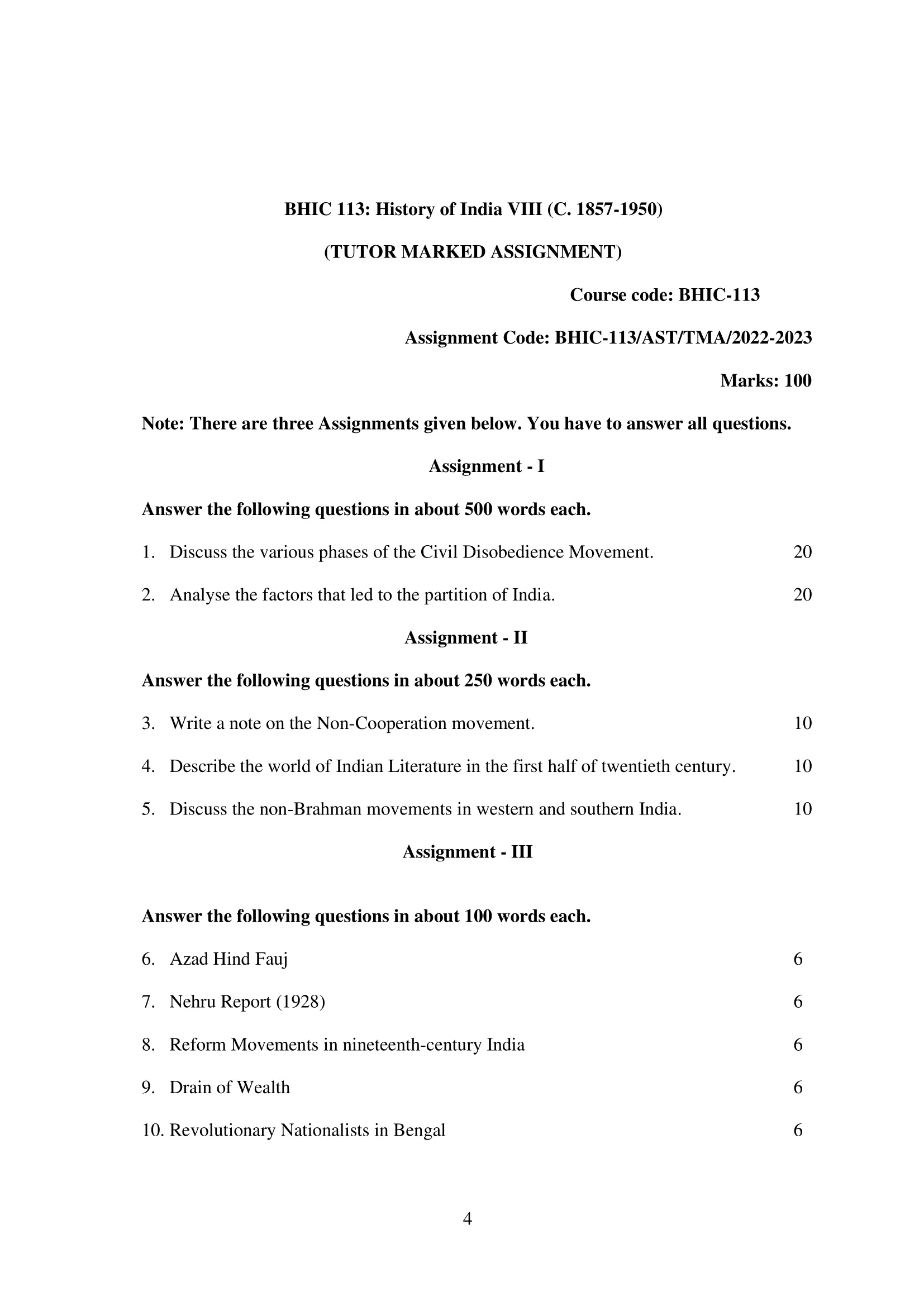
Assignment – I
Answer the following questions in about 500 words each.
1. Discuss the various phases of the Civil Disobedience Movement.
Ans: The Civil Disobedience Movement, also known as the Salt March, was a significant event in the Indian independence movement that took place from 1930 to 1934. The movement was led by Mohandas Gandhi, who aimed to protest against the British government’s monopoly on salt production and its unjust tax laws. The movement consisted of various phases, each with its own distinct characteristics and objectives.
The first phase of the Civil Disobedience Movement started in March 1930 with the Salt March. Gandhi and a group of followers marched from Ahmedabad to the Arabian Sea, covering a distance of 241 miles, to protest against the British government’s salt monopoly. The march symbolized Gandhi’s nonviolent resistance against the British government’s oppressive policies and his commitment to Indian independence.
The second phase of the Civil Disobedience Movement was characterized by widespread protests and acts of noncooperation across India. This phase started with the famous Dandi March, where Gandhi and a group of followers broke the salt law by making salt from seawater. This act of defiance inspired millions of Indians to participate in the movement and protest against the British government’s unjust policies.
The third phase of the Civil Disobedience Movement was marked by mass arrests and repression by the British government. In response to the widespread protests, the British government enacted laws that made it easier to arrest and detain Indian activists. Gandhi and thousands of others were arrested, and many were subjected to brutal punishment and torture. Despite the repression, the movement continued to gain momentum, with more and more Indians joining the cause.
The fourth phase of the Civil Disobedience Movement was marked by a shift in strategy. Gandhi and the Indian National Congress decided to call off the movement in 1934 and focus on negotiations with the British government. This change in strategy was a result of Gandhi’s belief that nonviolence and peaceful negotiations were the best way to achieve independence. The negotiations ultimately failed, and the movement was resumed in 1942 with the launch of the Quit India Movement.
2. Analyse the factors that led to the partition of India.
Ans: The partition of India in 1947 was a historic event that resulted in the creation of two independent countries, India and Pakistan. The partition was the result of various political, religious, and cultural factors that had been brewing for several decades. In this essay, I will analyze the factors that led to the partition of India.
One of the primary factors that led to the partition of India was religious differences between Hindus and Muslims. India had a long history of religious conflict, and these tensions only escalated as the independence movement gained momentum. Hindu nationalism, which advocated for a Hindu-majority India, and Muslim nationalism, which sought a separate state for Muslims, became increasingly polarized. The Hindu-Muslim divide was further exacerbated by the demand for separate electorates for the two communities, which the British government granted in 1909.
Another factor that contributed to the partition of India was the politics of the Indian National Congress and the Muslim League. The Indian National Congress, which was dominated by Hindus, advocated for a secular, democratic India that would accommodate the interests of all communities. The Muslim League, on the other hand, was a Muslim-centric political party that sought a separate state for Muslims. The two parties were unable to find a common ground, and this political divide further intensified the Hindu-Muslim divide.
A third factor that led to the partition of India was British imperialism. The British had ruled India for over 200 years and had exploited the country for its own benefit. As the independence movement gained momentum, the British government sought to divide and rule the Indian subcontinent to maintain its influence in the region. The British government’s policies, such as the creation of separate electorates for Hindus and Muslims, further deepened the religious and political divide between the two communities.
Another important factor that led to the partition of India was the economic interests of the British. The British wanted to ensure that India’s economic resources would be accessible to them even after independence. The partition of India allowed the British to maintain control over the wealthy and industrially advanced areas of the country, such as Punjab and Bengal.
Finally, the role of leaders such as Mohandas Gandhi and Jinnah also played a significant role in the partition of India. Gandhi’s commitment to nonviolence and his belief in Hindu-Muslim unity were seen as threats by those who advocated for a separate Muslim state. Jinnah, on the other hand, was a strong advocate for a separate Muslim state and was instrumental in the creation of Pakistan.
Assignment – II
Answer the following questions in about 250 words each.
3. Write a note on the Non-Cooperation movement.
Ans: The Non-Cooperation movement was a political campaign launched in India in 1920 by the Indian National Congress. The movement was led by Mahatma Gandhi, who advocated for non-violent resistance against British rule in India. The movement was launched as a response to the British government’s repressive measures against Indian political activists, including the Rowlatt Acts and the Jallianwala Bagh massacre.
The Non-Cooperation movement called for Indians to boycott British goods and institutions, including schools, courts, and government offices. The movement also encouraged the use of indigenous goods and the promotion of khadi (hand-spun cloth). Gandhi believed that this boycott would put economic pressure on the British government and force them to change their policies towards India.
The Non-Cooperation movement was initially successful, attracting widespread support from Indian people. However, it was eventually called off after the violent incident at Chauri Chaura in 1922, where a group of protestors burned down a police station, killing several police officers. Gandhi felt that the violence went against the principles of non-violence that he had espoused, and he felt that he could no longer lead the movement.
Despite its ultimate failure, the Non-Cooperation movement was a significant moment in Indian history. It marked the beginning of mass political mobilization in India, and it demonstrated that Indians were willing to resist British rule. The movement also inspired future campaigns for independence, including the Salt March in 1930 and the Quit India Movement in 1942.
4. Describe the world of Indian Literature in the first half of twentieth century.
Ans: The first half of the twentieth century was a significant period for Indian literature, marked by the emergence of several new literary movements and the emergence of several influential writers. The period saw the growth of Indian writing in English, as well as the flowering of regional languages, such as Bengali, Hindi, Marathi, and Urdu.
In the early part of the century, Indian literature was heavily influenced by Western literary traditions and styles, including Romanticism and Modernism. This was evident in the works of writers like Rabindranath Tagore, who wrote poems and plays that combined Indian themes and styles with Western literary techniques. Tagore’s works, such as his collection of poems Gitanjali, had a profound impact on Indian literature and earned him the Nobel Prize in Literature in 1913.
The late 1910s and 1920s saw the emergence of the Indian Renaissance, a cultural and intellectual movement that sought to reclaim India’s rich cultural heritage and reinvigorate Indian identity. This movement was reflected in the works of writers like Nirala, who wrote in Hindi and sought to bridge the gap between traditional Indian literary styles and modern literary techniques.
The 1940s and 1950s saw the rise of Indian writing in English, with writers like Mulk Raj Anand, Raja Rao, and R.K. Narayan. These writers explored Indian themes and themes of nationalism, caste, and colonialism through a Western literary lens, producing works that were at once Indian and universal in their appeal. These writers were part of the “Anglo-Indian” literary tradition, which sought to create a space for Indian writing in English and establish Indian literature as a legitimate part of the Western literary canon.
5. Discuss the non-Brahman movements in western and southern India.
Ans: The non-Brahman movements were a series of political and social movements that emerged in western and southern India in the late 19th and early 20th centuries. These movements sought to challenge the dominance of the Brahmin caste, which held a monopoly on political and cultural power in India. The non-Brahman movements aimed to promote the interests of lower castes and marginalized communities, and to promote social and economic equality in Indian society.
The earliest of these movements was the Justice Party, which was founded in 1916 in the Madras Presidency (present-day Tamil Nadu). The Justice Party sought to represent the interests of the non-Brahmin communities in the region, including Dalits (formerly known as “untouchables”), non-Brahmin Shudras, and other lower-caste communities. The party gained political power in the Madras Presidency in the 1920s and 1930s, and implemented policies aimed at promoting social and economic equality, including affirmative action programs for lower-caste communities.
In Maharashtra, a similar movement emerged in the form of the Samyukta Maharashtra Movement. This movement sought to establish a separate state for the Marathi-speaking people of the region, and was driven by concerns over linguistic and cultural marginalization. The movement gained momentum in the 1950s and ultimately led to the creation of the state of Maharashtra in 1960.
In Kerala, the non-Brahmin movement took the form of the Kerala Socialist Party, which was founded in 1940. The party sought to promote the interests of lower-caste communities in the state and to challenge the dominance of the upper-caste Nambudiri Brahmins. The party gained political power in the state in the late 1940s and 1950s and implemented policies aimed at promoting social and economic equality, including land reforms and affirmative action programs for lower-caste communities.
Assignment – III
Answer the following questions in about 100 words each.
6. Azad Hind Fauj
Ans: The Azad Hind Fauj, also known as the Indian National Army (INA), was a military force formed by Indian nationalist leader Subhas Chandra Bose during World War II. The INA was established in 1942, with the aim of liberating India from British colonial rule and establishing an independent Indian state. The INA was comprised primarily of Indian prisoners of war who had been captured by the Japanese during their invasion of Southeast Asia. Bose and the INA sought to use Japan’s military might to support their cause, and the INA saw limited combat in Burma and India before being disbanded at the end of the war. The INA and Bose’s leadership of the organization remain a source of inspiration for Indian nationalism, and are considered an important part of India’s struggle for independence from British rule.
7. Nehru Report (1928)
Ans: The Nehru Report was a political document written in 1928 by a committee headed by Indian nationalist leader Jawaharlal Nehru. The report was produced in response to the British government’s invitation for Indian leaders to suggest reforms to the existing constitutional framework in India. The Nehru Report was seen as an important milestone in India’s struggle for independence from British rule, as it was one of the first major attempts by Indian leaders to articulate a vision for an independent India.
The report called for the establishment of a federal system of government in India, with significant powers devolved to the provinces. It also advocated for the protection of minority rights and the abolition of the system of communal electorates. Additionally, the report called for the introduction of universal adult franchise, and for the establishment of civil liberties and fundamental rights.
Despite its significance, the Nehru Report was largely ignored by the British government and did not lead to any significant reforms in India’s constitutional framework. However, it remains an important part of India’s independence movement, and is considered a landmark in the development of Indian nationalism and the articulation of Indian aspirations for independence and self-rule.
8. Reform Movements in nineteenth-century India
Ans: The 19th century in India was characterized by a series of reform movements that sought to challenge traditional social, cultural, and religious practices and to promote a more progressive and modern society. These reform movements were driven by a variety of factors, including contact with Western ideas and values, the growth of an educated middle class, and a desire to modernize Indian society in response to the challenges posed by British colonial rule.
One of the key reform movements of the 19th century was the Brahmo Samaj, which was founded in 1828 by Raja Ram Mohan Roy. The Brahmo Samaj sought to promote the principles of monotheism and the rejection of idol worship, and it played a major role in promoting social and religious reform in India. Other important reform movements of the 19th century included the Prarthana Samaj, the Theosophical Society, and the Arya Samaj.
In addition to religious reform, the 19th century also saw a number of movements aimed at promoting social and political reform. For example, the Indian National Congress was founded in 1885, and it played a key role in the Indian independence movement. Other important political movements of the 19th century included the Swadeshi movement, which sought to promote Indian self-sufficiency and to reject British goods, and the Indian Association, which sought to promote political awareness and to encourage Indian participation in politics.
9. Drain of Wealth
Ans: The Drain of Wealth was a term used by Indian economists and political leaders in the late 19th and early 20th centuries to describe the economic exploitation of India by Britain during the period of colonial rule. The Drain of Wealth theory held that Britain was draining India of its resources and wealth through various means, including the transfer of profits from Indian industries and trade to Britain, the payment of high salaries to British officials and military personnel stationed in India, and the large sums of money spent on military adventures and imperial projects.
The theory was first articulated by Dadabhai Naoroji in his book “Poverty and Un-British Rule in India,” which was published in 1901. Naoroji argued that Britain’s rule was draining India of its wealth and resources, leading to widespread poverty and underdevelopment in the country. The Drain of Wealth theory was widely adopted by Indian nationalist leaders and played a key role in shaping the independence movement and the demand for self-rule and independence from British rule.
10. Revolutionary Nationalists in Bengal
Ans: Revolutionary Nationalists in Bengal refer to a group of Indian independence activists and political leaders in the early 20th century who advocated for independence from British rule through revolutionary means. These activists were primarily based in Bengal, which was then one of the most important regions of India, both economically and culturally.
The Revolutionary Nationalists in Bengal were inspired by the ideas of nationalism and anti-colonialism, and were frustrated with the slow pace of reforms and the limited success of constitutional and political means of achieving independence. As a result, they adopted a more militant and radical approach, and sought to use violence and other means to challenge British rule and to bring about independence.
Some of the most prominent Revolutionary Nationalists in Bengal included people such as Bhagat Singh, Chandra Shekhar Azad, and Surya Sen. These activists and leaders played a key role in shaping the independence movement in Bengal and India more broadly, and their ideas and actions continue to inspire nationalist and anti-colonial movements around the world.
How to Download BHIC-113 Solved Assignment?
You can download it from the www.edukar.in, they have a big database for all the IGNOU solved assignments.
Is the BHIC-113 Solved Assignment Free?
Yes this is absolutely free to download the solved assignment from www.edukar.in
What is the last submission date for BHIC-113 Solved Assignment?
For June Examination: 31st April, For December Examination: 30th October

